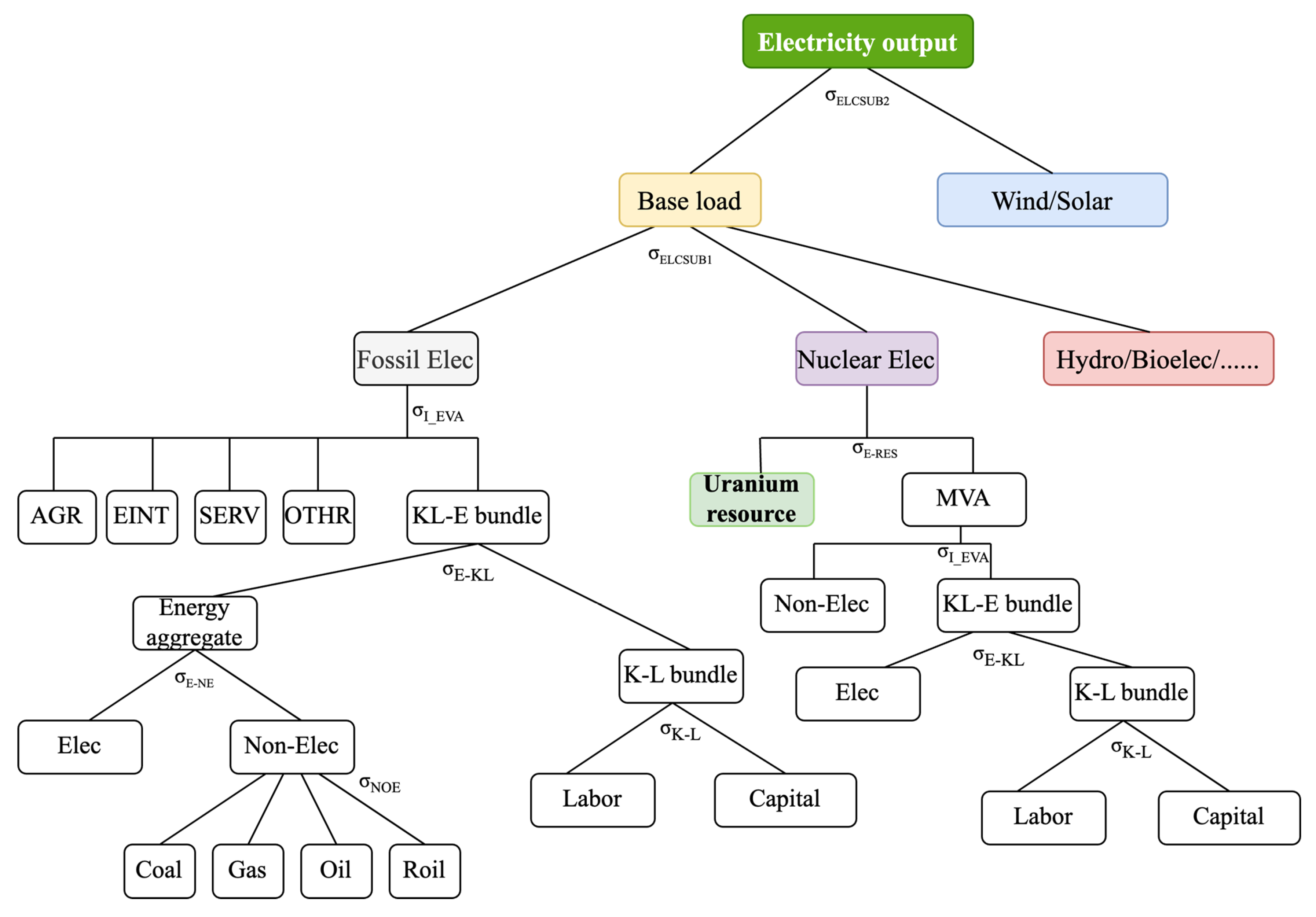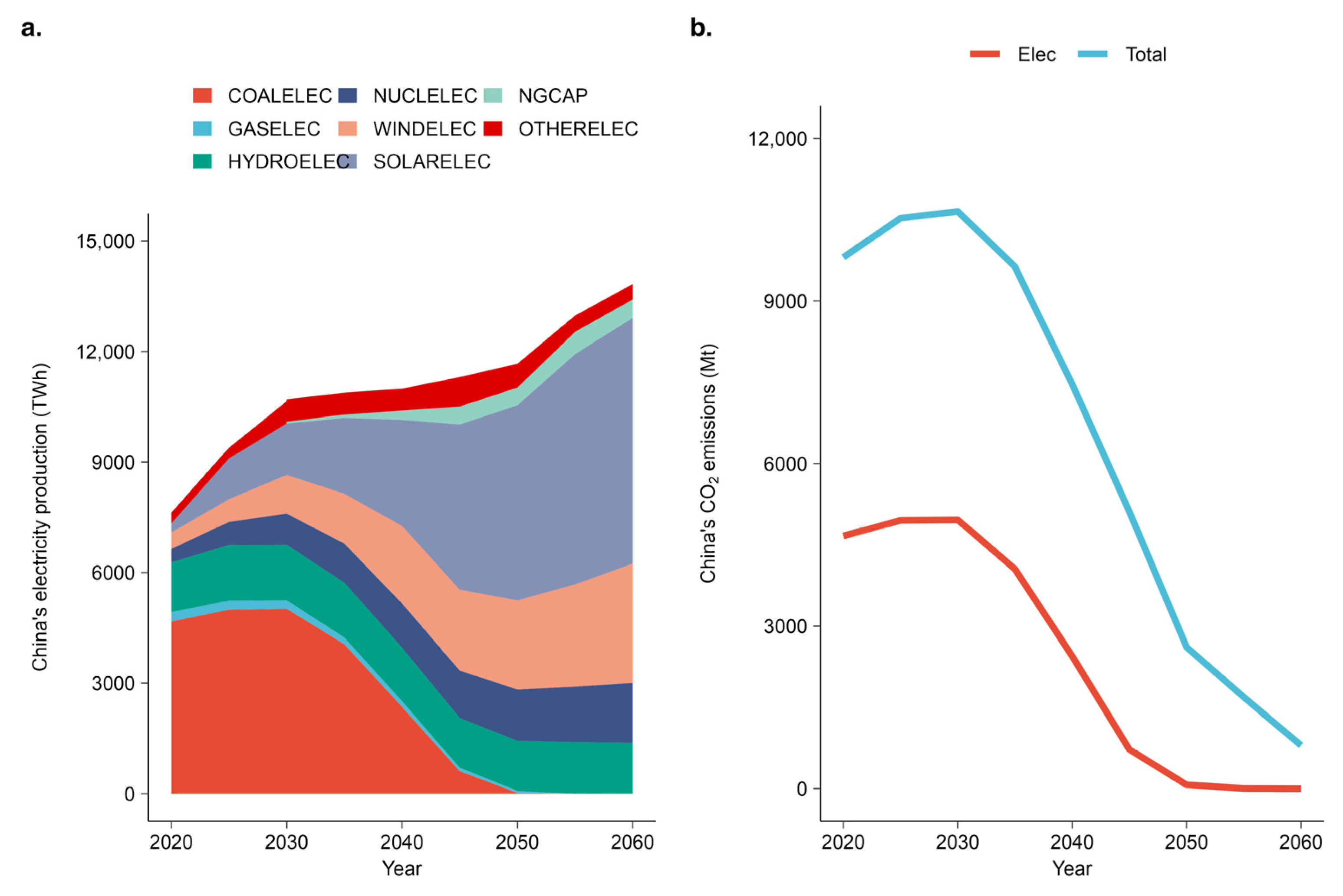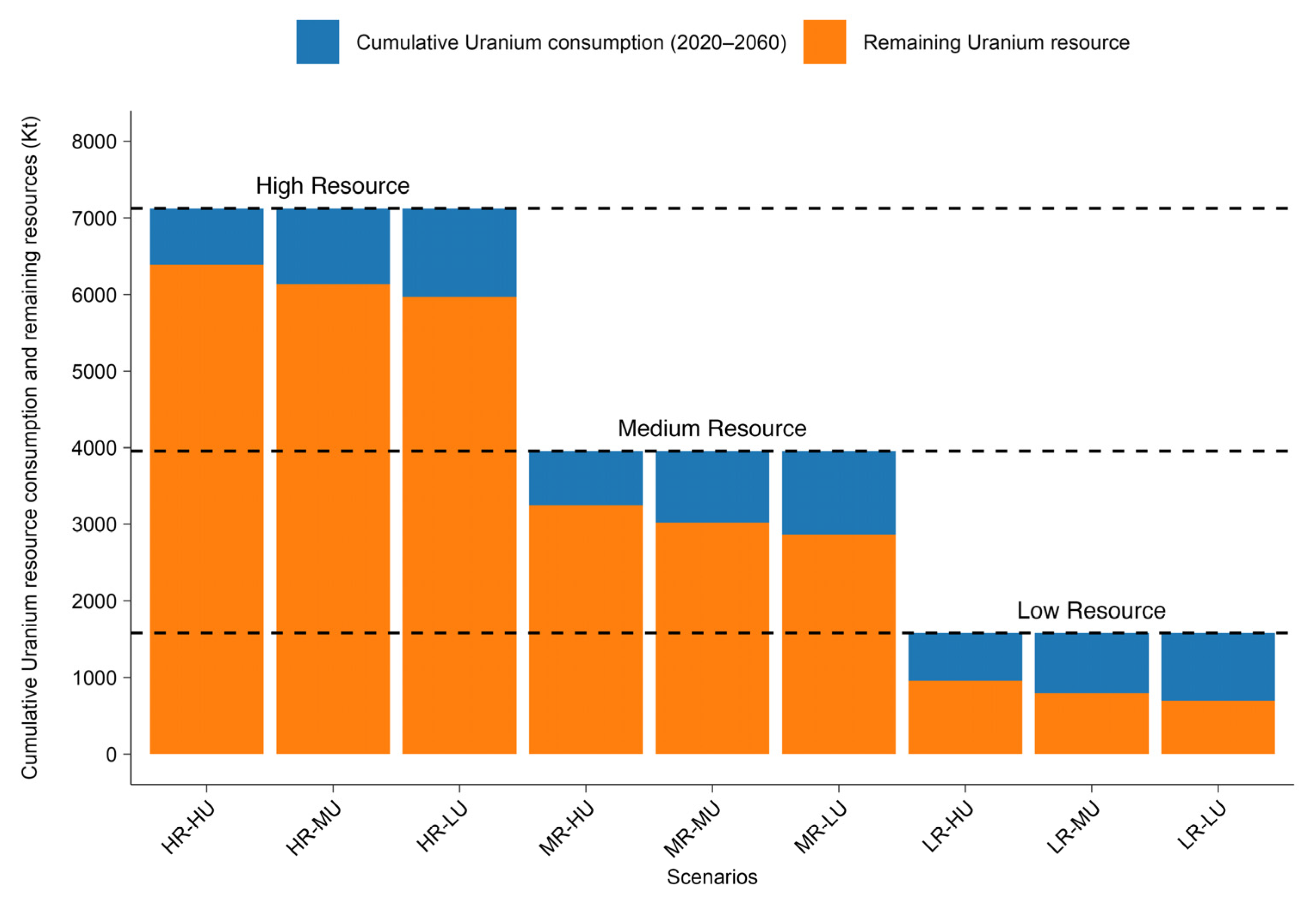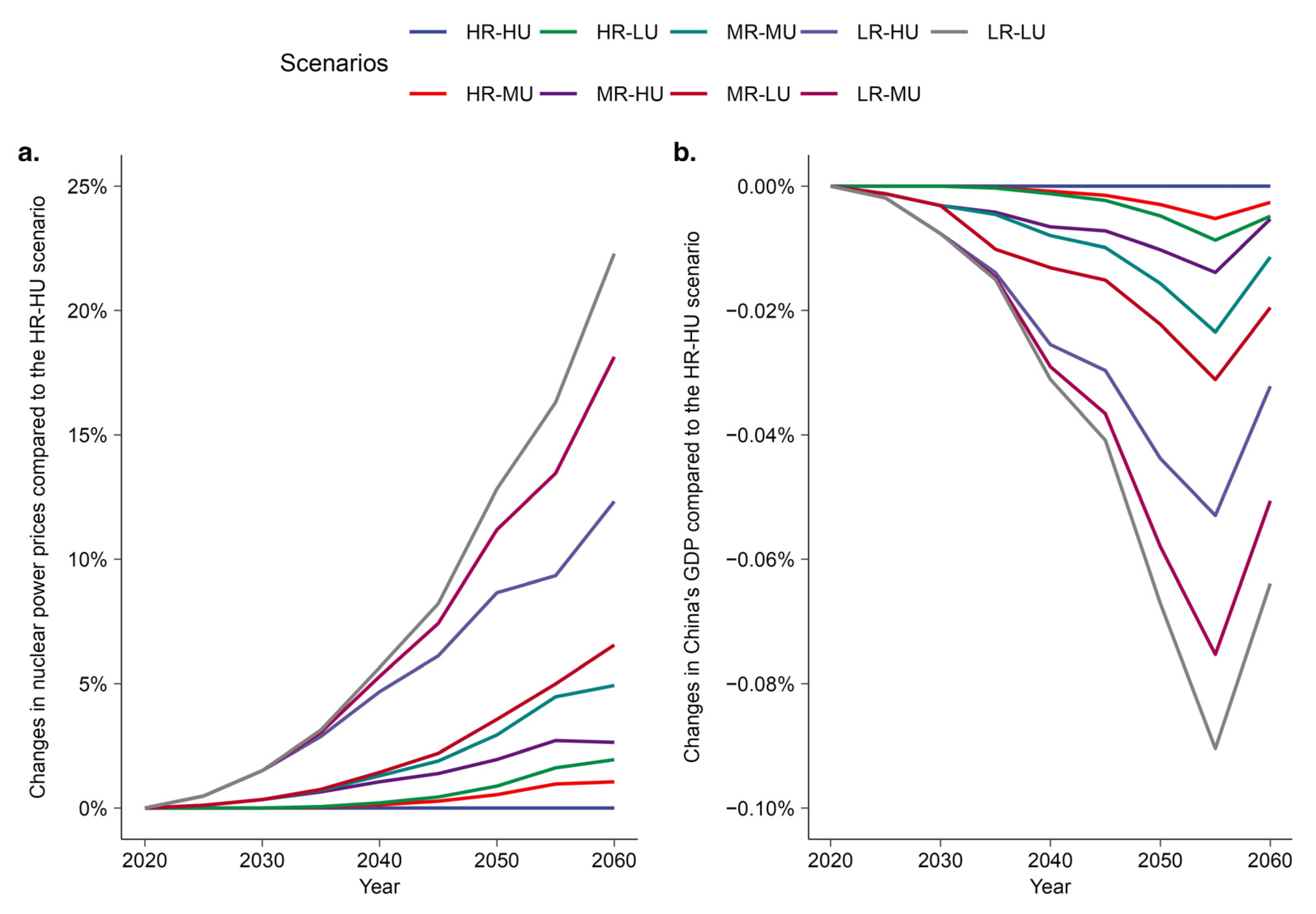The Impact of Uranium Resource Constraints on China’s Nuclear Power Development
Abstract
1. Introduction
2. Data and Methodology
2.1. Overview of the C-GEM Model
2.2. Power System Simulation and Uranium Resource Constraint Modeling in the C-GEM Model
3. Scenario Construction
3.1. Establishing Resource Quantity Scenarios
- High Resource Quantity Scenario (HR): Assumes that China has access to 90% of the global uranium reserves reported in the document, reflecting an exceedingly optimistic resource scenario.
- Medium Resource Quantity Scenario (MR): Assumes that 50% of the global uranium resources are accessible for China’s nuclear power development, embodying a moderately optimistic outlook.
- Low Resource Quantity Scenario (LR): Assumes that only 20% of the global uranium resources are accessible for China’s nuclear power development, portraying a relatively pessimistic scenario of resource scarcity.
3.2. Setting of Uranium Resource Utilization Rate Scenarios
- High Uranium Resource Utilization Scenario (HU): Envisages a swift progression in fast reactor and reprocessing technologies, resulting in a 3% annual increase in uranium resource utilization efficiency after 2030.
- Medium Uranium Resource Utilization Scenario (MU): Foresees a gradual reduction in the quantity of uranium resources consumed per TWh of nuclear power generation post-2030, with an annual decline of 1% from the current average level. This reflects ongoing technological enhancements and the bolstering of uranium utilization efficiency.
- Low Uranium Resource Utilization Scenario (LU): Presumes that the uranium resource utilization efficiency remains stagnant at current levels until 2060.
4. Result
4.1. Under Uranium Resource Constraints: Power Production Structure and Uranium Consumption
4.2. Economic Impacts of Uranium Resource Constraints
4.3. Sensitivity Analysis
5. Conclusions and Discussions
Supplementary Materials
Author Contributions
Funding
Data Availability Statement
Conflicts of Interest
References
- Meinshausen, M.; Lewis, J.; McGlade, C.; Gütschow, J.; Nicholls, Z.; Burdon, R.; Cozzi, L.; Hackmann, B. Realization of Paris Agreement pledges may limit warming just below 2 °C. Nature 2022, 604, 304–309. [Google Scholar] [CrossRef] [PubMed]
- Yu, H.; Wen, B.; Zahidi, I.; Chow, M.F.; Liang, D.; Madsen, D.Ø. The critical role of energy transition in addressing climate change at COP28. Results Eng. 2024, 22, 102324. [Google Scholar] [CrossRef]
- UNFCCC. 1/CMA.5 Outcome of the First Global Stocktake; United Nations Framework Convention on Climate Change: Bonn, Germany, 2024; Available online: https://unfccc.int/documents/637073 (accessed on 13 March 2025).
- Liu, L.; Guo, H.; Dai, L.; Liu, M.; Xiao, Y.; Cong, T.; Gu, H. The role of nuclear energy in the carbon neutrality goal. Prog. Nucl. Energy 2023, 162, 104772. [Google Scholar] [CrossRef]
- Wang, Q.; Guo, J.; Li, R.; Jiang, X.-t. Exploring the role of nuclear energy in the energy transition: A comparative perspective of the effects of coal, oil, natural gas, renewable energy, and nuclear power on economic growth and carbon emissions. Environ. Res. 2023, 221, 115290. [Google Scholar] [CrossRef]
- IAEA. The Potential Role of Nuclear Energy in National Climate Change Mitigation Strategies; International Atomic Energy Agency: Vienna, Austria, 2021; Available online: https://www.iaea.org/publications/15001/the-potential-role-of-nuclear-energy-in-national-climate-change-mitigation-strategies (accessed on 13 March 2025).
- UNECE. Carbon Neutrality in the UNECE Region: Integrated Life-Cycle Assessment of Electricity Sources; United Nations Economic Commission for Europe: Batumi, Georgia, 2022; Available online: https://www.un-ilibrary.org/content/books/9789210014854 (accessed on 13 March 2025).
- IEA. Nuclear Power and Secure Energy Transitions; International Energy Agency: Paris, France, 2022; Available online: https://www.iea.org/reports/nuclear-power-and-secure-energy-transitions (accessed on 13 March 2025).
- Azam, A.; Rafiq, M.; Shafique, M.; Yuan, J. Does nuclear or renewable energy consumption help to control environmental pollution? New evidence from China. Renew. Energy Focus 2021, 39, 139–147. [Google Scholar] [CrossRef]
- Zhou, Y. Why is China going nuclear? Energy Policy 2010, 38, 3755–3762. [Google Scholar] [CrossRef]
- Zhou, Y. China’s spent nuclear fuel management: Current practices and future strategies. Energy Policy 2011, 39, 4360–4369. [Google Scholar] [CrossRef]
- Wang, T.; Teng, F. Damage function uncertainty increases the social cost of methane and nitrous oxide. Nat. Clim. Change 2023, 13, 1258–1265. [Google Scholar] [CrossRef]
- Alonso, G. Economic Competitiveness of Small Modular Reactors in a Net Zero Policy. Energies 2025, 18, 922. [Google Scholar] [CrossRef]
- Yang, H.; Huang, X.; Hu, J.; Thompson, J.R.; Flower, R.J. Achievements, challenges and global implications of China’s carbon neutral pledge. Front. Environ. Sci. Eng. 2022, 16, 111. [Google Scholar] [CrossRef]
- Yu, S.; Fu, S.; Behrendt, J.; Chai, Q.; Chen, L.; Chen, W.; Cheng, X.; Clarke, L.; Du, X.; Guo, F. Synthesis Report 2022 on China’s Carbon Neutrality: Electrification in China’s Carbon Neutrality Pathways; Energy Foundation China: Beijing, China, 2022; Available online: https://www.efchina.org/Reports-en/report-snp-20221104-en (accessed on 13 March 2025).
- Luo, S.; Hu, W.; Liu, W.; Zhang, Z.; Bai, C.; Huang, Q.; Chen, Z. Study on the decarbonization in China’s power sector under the background of carbon neutrality by 2060. Renew. Sustain. Energy Rev. 2022, 166, 112618. [Google Scholar] [CrossRef]
- Jiang, H.-D.; Pradhan, B.K.; Dong, K.; Yu, Y.-Y.; Liang, Q.-M. An economy-wide impacts of multiple mitigation pathways toward carbon neutrality in China: A CGE-based analysis. Energy Econ. 2024, 129, 107220. [Google Scholar] [CrossRef]
- Liu, S.; Jiang, Y.; Yu, S.; Tan, W.; Zhang, T.; Lin, Z. Electric power supply structure transformation model of China for peaking carbon dioxide emissions and achieving carbon neutrality. Energy Rep. 2022, 8, 541–548. [Google Scholar] [CrossRef]
- Gabriel, S.; Baschwitz, A.; Mathonnière, G.; Eleouet, T.; Fizaine, F. A critical assessment of global uranium resources, including uranium in phosphate rocks, and the possible impact of uranium shortages on nuclear power fleets. Ann. Nucl. Energy 2013, 58, 213–220. [Google Scholar] [CrossRef]
- Cuney, M. Evolution of uranium fractionation processes through time: Driving the secular variation of uranium deposit types. Econ. Geol. 2010, 105, 553–569. [Google Scholar] [CrossRef]
- NEA/IAEA. Uranium 2022: Resources, Production and Demand; Nuclear Energy Agency and International Atomic Energy Agency: Vienna, Austria, 2023. [Google Scholar] [CrossRef]
- DIIS. Governing Uranium in Canada: The world’s largest all-time uranium producer; Danish Institute for International Studies: København, Denmark, 2016; Available online: https://www.diis.dk/en/research/governing-uranium-in-canada-the-worlds-largest-all-time-uranium-producer (accessed on 13 March 2025).
- Islam, M.M.; Shahbaz, M.; Samargandi, N. The nexus between Russian uranium exports and US nuclear-energy consumption: Do the spillover effects of geopolitical risks matter? Energy 2024, 293, 130481. [Google Scholar] [CrossRef]
- Wang, T.; Tao, B.; Zuo, B.; Yan, G.; Liu, S.; Wang, R.; Zhao, Z.; Chu, F.; Li, Z.; Yamauchi, Y. Challenges and Opportunities of Uranium Extraction From Seawater: A Systematic Roadmap From Laboratory to Industry. Small Methods 2024, 2401598. [Google Scholar] [CrossRef]
- Zhu, W.; Li, X.; Wang, D.; Fu, F.; Liang, Y. Advanced Photocatalytic Uranium Extraction Strategies: Progress, Challenges, and Prospects. Nanomaterials 2023, 13, 2005. [Google Scholar] [CrossRef]
- Shannak, S.d.; Cochrane, L.; Bobarykina, D. Global uranium market dynamics: Analysis and future implications. Int. J. Sustain. Energy 2025, 44, 2457376. [Google Scholar] [CrossRef]
- Mirkhusanov, U.T.; Semenova, D.Y.; Kharitonov, V.V. Forecasting the cost and volume of uranium mining for different world nuclear energy development scenarios. Nucl. Energy Technol. 2024, 10, 131–137. [Google Scholar] [CrossRef]
- Chen, Y.; Martin, G.; Chabert, C.; Eschbach, R.; He, H.; Ye, G.-a. Prospects in China for nuclear development up to 2050. Prog. Nucl. Energy 2018, 103, 81–90. [Google Scholar] [CrossRef]
- Xing, W.; Wang, A.; Yan, Q.; Chen, S. A study of China’s uranium resources security issues: Based on analysis of China’s nuclear power development trend. Ann. Nucl. Energy 2017, 110, 1156–1164. [Google Scholar] [CrossRef]
- Zhang, J.-p.; Liu, Z.-r.; Wang, L. Uranium demand and economic analysis of different nuclear fuel cycles in China. Energy Strategy Rev. 2016, 9, 50–61. [Google Scholar] [CrossRef]
- Guang, Y.; Wenjie, H. The status quo of China’s nuclear power and the uranium gap solution. Energy Policy 2010, 38, 966–975. [Google Scholar] [CrossRef]
- Fiori, F.; Zhou, Z. Sustainability of the Chinese nuclear expansion: Natural uranium resources availability, Pu cycle, fuel utilization efficiency and spent fuel management. Ann. Nucl. Energy 2015, 83, 246–257. [Google Scholar] [CrossRef]
- Wang, T.; Lu, Y.; Teng, F.; Zhang, X.; Zhang, X.; Wei, M.; Wu, T.; Wang, D.; Sun, J.; Zhong, J. Coupling natural-social models can better quantify the interactions in achieving carbon neutrality in China. Environ. Res. Lett. 2025, 20, 024026. [Google Scholar] [CrossRef]
- Xiao, X.-J.; Jiang, K.-J. China’s nuclear power under the global 1.5 °C target: Preliminary feasibility study and prospects. Adv. Clim. Change Res. 2018, 9, 138–143. [Google Scholar] [CrossRef]
- Yu, S.; Yarlagadda, B.; Siegel, J.E.; Zhou, S.; Kim, S. The role of nuclear in China’s energy future: Insights from integrated assessment. Energy Policy 2020, 139, 111344. [Google Scholar] [CrossRef]
- Zhang, T.; Ma, Y.; Li, A. Scenario analysis and assessment of China’s nuclear power policy based on the Paris Agreement: A dynamic CGE model. Energy 2021, 228, 120541. [Google Scholar] [CrossRef]
- Huang, X.; Chang, S.; Zheng, D.; Zhang, X. The role of BECCS in deep decarbonization of China’s economy: A computable general equilibrium analysis. Energy Econ. 2020, 92, 104968. [Google Scholar] [CrossRef]
- Qi, T.; Winchester, N.; Karplus, V.J.; Zhang, D.; Zhang, X. An analysis of China’s climate policy using the China-in-Global Energy Model. Econ. Model. 2016, 52, 650–660. [Google Scholar] [CrossRef]
- Wang, T.; Teng, F.; Zhang, X. Assessing global and national economic losses from climate change: A study based on CGEM-IAM in China. Clim. Change Econ. 2020, 11, 2041003. [Google Scholar] [CrossRef]
- Aguiar, A.; Chepeliev, M.; Corong, E.; van der Mensbrugghe, D. The Global Trade Analysis Project (GTAP) Data Base: Version 11. J. Glob. Econ. Anal. 2023, 7, 1–37. [Google Scholar] [CrossRef]
- Hotelling, H. The Economics of Exhaustible Resources. J. Pol. Econ. 1931, 39, 137–175. [Google Scholar] [CrossRef]
- Livernois, J. On the Empirical Significance of the Hotelling Rule. Rev. Environ. Econ. Policy 2009, 3, 22–41. [Google Scholar] [CrossRef]
- Simoes, A.J.G.; Hidalgo, C.A. The Economic Complexity Observatory: An Analytical Tool for Understanding the Dynamics of Economic Development. Scalable Integr. Anal. Vis. 2011, 11, 1–4. [Google Scholar]
- Stanisz, P.; Oettingen, M.; Cetnar, J. Monte Carlo modeling of Lead-Cooled Fast Reactor in adiabatic equilibrium state. Nucl. Eng. Des. 2016, 301, 341–352. [Google Scholar] [CrossRef]
- Oettingen, M. Modelling of the reactor cycle cost for thorium-fuelled PWR and environmental aspects of a nuclear fuel cycle. Geol. Geophys. Environ. 2019, 45, 207. [Google Scholar] [CrossRef]
- Abderrahim, H.A.; Giot, M. The Accelerator Driven Systems, a 21st Century Option for Closing Nuclear Fuel Cycles and Transmuting Minor Actinides. Sustainability 2021, 13, 12643. [Google Scholar] [CrossRef]
- Xie, Y.; Liu, Z.; Geng, Y.; Li, H.; Wang, N.; Song, Y.; Wang, X.; Chen, J.; Wang, J.; Ma, S. Uranium extraction from seawater: Material design, emerging technologies and marine engineering. Chem. Soc. Rev. 2023, 52, 97–162. [Google Scholar] [CrossRef]
- Wakabayashi, T. Concept of a fast breeder reactor to transmute MAs and LLFPs. Sci. Rep. 2021, 11, 22443. [Google Scholar] [CrossRef] [PubMed]
- NBS. China Statistical Yearbook. National Bureau of Statistics of China. 2023. Available online: https://www.stats.gov.cn/sj/ndsj/2023/indexeh.htm (accessed on 13 March 2025).
- NBS. China Energy Statistical Yearbook. National Bureau of Statistics. 2023. Available online: https://www.chinayearbooks.com/tags/china-energy-statistical-yearbook (accessed on 13 March 2025).
- WNA. The Nuclear Fuel Report: Global Scenarios for Demand and Supply Availability 2023–2040. World Nuclear Association. 2024. Available online: https://world-nuclear.org/shop/products/the-nuclear-fuel-report-global-scenarios-for (accessed on 13 March 2025).






| Substitution Elasticity Between Uranium Resources and Other Inputs | Markup Cost of Nuclear Electricity | ||||||||
|---|---|---|---|---|---|---|---|---|---|
| Change from 0 to 0.1 | Increase by 10% | Decrease by 10% | |||||||
| Nuc. Gen. | Nuc. Elec. Price | CO2 Price | Nuc. Gen. | Nuc. Elec. Price | CO2 Price | Nuc. Gen. | Nuc. Elec. Price | CO2 Price | |
| HR-HU | 12.9% | −2.6% | −0.3% | −8.8% | 0.3% | 2.6% | 10.2% | −0.1% | −2.1% |
| HR-MU | 12.9% | −2.8% | −0.4% | −8.5% | 0.3% | 2.7% | 9.7% | −0.1% | −2.2% |
| HR-LU | 12.9% | −3.0% | −0.4% | −8.2% | 0.3% | 2.6% | 9.4% | −0.2% | −2.3% |
| MR-HU | 13.3% | −3.2% | −0.5% | −8.2% | 0.3% | 2.5% | 9.3% | −0.3% | −2.5% |
| MR-MU | 13.1% | −3.5% | −0.6% | −7.5% | 0.2% | 2.3% | 8.3% | −0.2% | −2.3% |
| MR-LU | 12.9% | −3.4% | −0.6% | −7.0% | 0.2% | 2.1% | 7.6% | −0.2% | −2.1% |
| LR-HU | 12.2% | −3.1% | −0.5% | −5.8% | 0.1% | 1.6% | 5.4% | −0.1% | −1.4% |
| LR-MU | 8.5% | −2.0% | −0.3% | −3.9% | 0.1% | 1.0% | 2.8% | 0.0% | −0.7% |
| LR-LU | 5.0% | −1.2% | −0.2% | −2.5% | 0.0% | 0.6% | 0.9% | 0.0% | −0.2% |
Disclaimer/Publisher’s Note: The statements, opinions and data contained in all publications are solely those of the individual author(s) and contributor(s) and not of MDPI and/or the editor(s). MDPI and/or the editor(s) disclaim responsibility for any injury to people or property resulting from any ideas, methods, instructions or products referred to in the content. |
© 2025 by the authors. Licensee MDPI, Basel, Switzerland. This article is an open access article distributed under the terms and conditions of the Creative Commons Attribution (CC BY) license (https://creativecommons.org/licenses/by/4.0/).
Share and Cite
Wang, T.; Wu, Z.; Xiong, W.; Pan, X.; Ye, X.; Liu, X. The Impact of Uranium Resource Constraints on China’s Nuclear Power Development. Energies 2025, 18, 1507. https://doi.org/10.3390/en18061507
Wang T, Wu Z, Xiong W, Pan X, Ye X, Liu X. The Impact of Uranium Resource Constraints on China’s Nuclear Power Development. Energies. 2025; 18(6):1507. https://doi.org/10.3390/en18061507
Chicago/Turabian StyleWang, Tianpeng, Ziqi Wu, Wei Xiong, Xunzhang Pan, Xuan Ye, and Xiaoguang Liu. 2025. "The Impact of Uranium Resource Constraints on China’s Nuclear Power Development" Energies 18, no. 6: 1507. https://doi.org/10.3390/en18061507
APA StyleWang, T., Wu, Z., Xiong, W., Pan, X., Ye, X., & Liu, X. (2025). The Impact of Uranium Resource Constraints on China’s Nuclear Power Development. Energies, 18(6), 1507. https://doi.org/10.3390/en18061507






